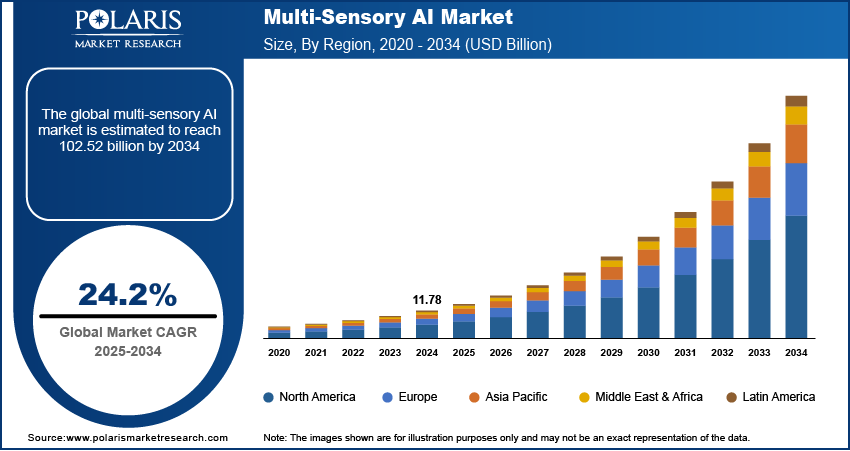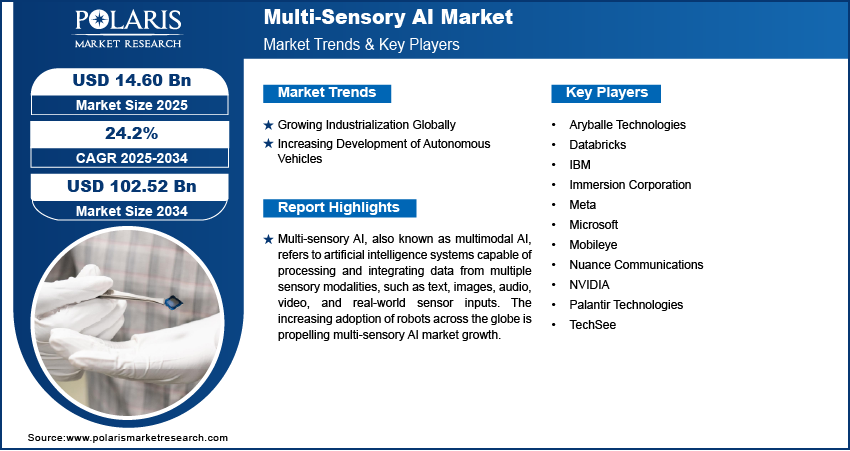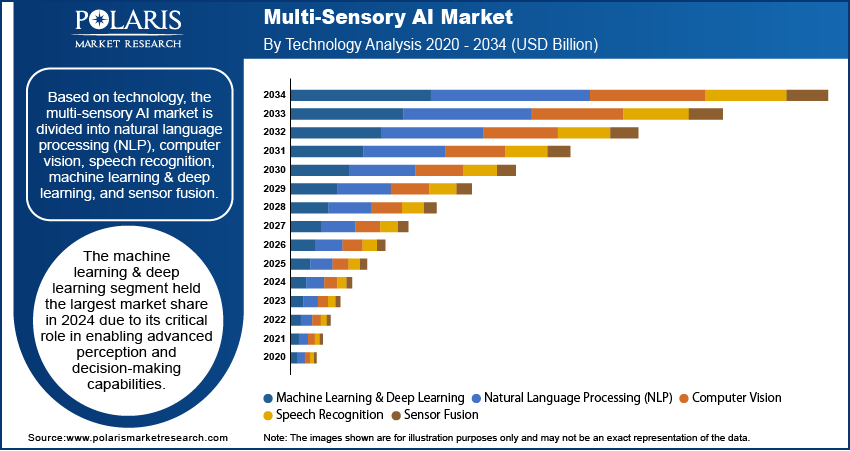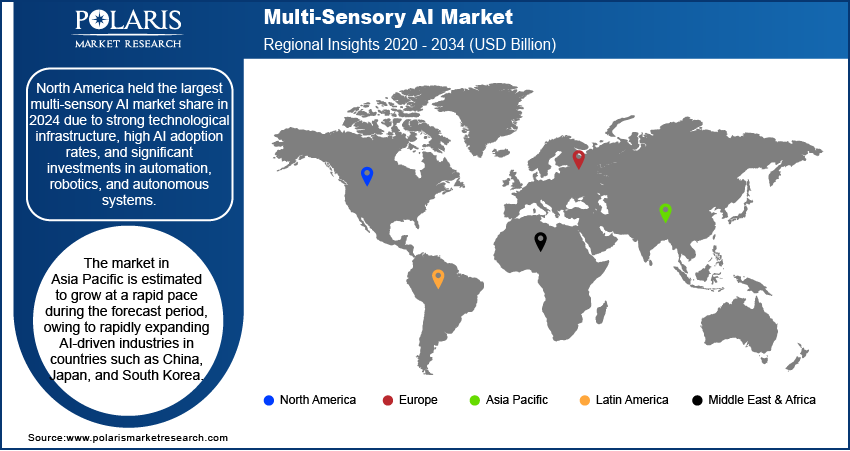
Multi-Sensory AI Market Size, Share, Trends, Industry Analysis Report: By Technology [Natural Language Processing (NLP), Computer Vision, Speech Recognition, Machine Learning & Deep Learning, and Sensor Fusion], Deployment Mode, Application, End User, and Region (North America, Europe, Asia Pacific, Latin America, and Middle East & Africa) – Market Forecast, 2025–2034
- Published Date:Apr-2025
- Pages: 129
- Format: pdf
- Report ID: PM5474
- Base Year: 2024
- Historical Data: 2020-2023
Multi-Sensory AI Market Overview
The global multi-sensory AI market size was valued at USD 11.78 billion in 2024. The market is projected to grow from USD 14.60 billion in 2025 to USD 102.52 billion by 2034, exhibiting a CAGR of 24.2% during 2025–2034.
Multi-sensory AI, also known as multimodal AI, refers to artificial intelligence systems capable of processing and integrating data from multiple sensory modalities, such as text, images, audio, video, and real-world sensor inputs. Multi-sensory AI systems are built using advanced machine learning architectures such as transformers and neural networks. These models include three key components: an input module for processing data from individual modalities, a fusion module for integrating these inputs, and an output module for generating insights or actions.
The increasing adoption of robots across the globe is propelling multi-sensory AI market growth. According to the World Robotics 2024 Service Robots report published by the International Federation of Robotics (IFR), sales of professional service robots increased by 30% in 2023 worldwide compared to 2022. Multi-sensory AI enables robots to integrate and interpret multiple data streams, improving their ability to navigate environments, manipulate objects, and interact with humans. This encourages businesses to invest in multi-sensory AI robotics for greater efficiency. The expansion of human-robot collaboration has further accelerated the demand for multi-sensory AI, as robots working alongside people must interpret speech, recognize facial expressions, and respond appropriately to physical cues. Therefore, the increasing adoption of robots is driving demand for multi-sensory AI by enhancing the robots' ability to interact with their environment, perform complex tasks, and enhance human-robot interaction.

To Understand More About this Research:Request a Free Sample Report
The multi-sensory AI market demand is driven by growing healthcare spending and infrastructure in emerging nations. For instance, the Ministry of Health and Family Welfare of India published data stating that the share of Government Health Expenditure (GHE) in the GDP increased from 1.13% in 2014-15 to 1.84% in 2021-22. Increased healthcare spending allows hospitals and clinics to integrate robotic systems for diagnostics, surgery, and patient care. These robots must process multiple sensory inputs, such as vision, touch, and sound, to perform complex medical procedures with accuracy, leading to high adoption of multi-sensory AI as it enables these robots to provide haptic feedback, allowing doctors to feel resistance during remote procedures. Moreover, multi-sensory AI enhances the efficiency and accessibility of healthcare services in emerging nations. Traditional healthcare systems often struggle with inefficiencies and limited resources, leading to delays in treatment and poor patient experiences. Multi-sensory AI optimizes healthcare services by automating routine tasks, such as patient monitoring and data analysis, freeing up healthcare professionals to provide more personalized care. This technology also enables remote monitoring and telehealth services, making healthcare more accessible to patients in rural or underserved areas. Hence, as healthcare spending and infrastructure in emerging nations such as India and Brazil grow, the demand for multi-sensory AI also spurs.
Multi-Sensory AI Market Dynamics
Growing Industrialization Globally
Industrialization leads to the deployment of robots to handle complex tasks that require real-time decision-making. Multi-sensory AI is crucial in these robots as it enables them to process visual, tactile, and auditory data simultaneously, improving their ability to detect defects, assemble complex components, and adapt to changing environments. The expansion of industrial sectors such as automotive, electronics, and pharmaceuticals has accelerated the need for multi-sensory AI. In automotive manufacturing, robots equipped with touch and vision sensors perform delicate assembly work, ensuring precision in tasks such as welding and painting. Electronics production requires AI-powered inspection systems that analyze microscopic details to detect defects in circuit boards. Pharmaceutical companies use robotic systems with advanced sensory capabilities to ensure accurate drug formulation and packaging. Thus, as industrialization spreads globally, businesses seek multi-sensory AI solutions to maintain competitiveness.
Increasing Development of Autonomous Vehicles
Autonomous vehicles rely on a combination of sensors, cameras, radar, LiDAR, and microphones to gather data about their surroundings. Multi-sensory AI integrates and processes this diverse data to enable vehicles to make faster decisions, ensuring safety and efficiency on the road. For instance, ZEEKR, an EV automaker, announced the launch of a new smart driving solution called G-Pilot, which will enable Level 3 autonomous driving in one of its upcoming EV models. In addition, the development of autonomous vehicles is driving innovation in AI algorithms and hardware. Companies are investing heavily in edge computing and AI chips to process multi-sensory data locally within the vehicle, reducing latency and improving response times. Therefore, the multi-sensory AI market is expanding with the rising development of autonomous vehicles.

Multi-Sensory AI Market Segment Insights
Multi-Sensory AI Market Evaluation by Technology
Based on technology, the multi-sensory AI market is divided into natural language processing (NLP), computer vision, speech recognition, machine learning & deep learning, and sensor fusion. The machine learning & deep learning segment held the largest multi-sensory AI market share in 2024 due to its critical role in enabling advanced perception and decision-making capabilities. Companies in healthcare, automotive, manufacturing, and robotics are increasingly integrating these technologies to enhance real-time data analysis, pattern recognition, and adaptive learning. The rapid growth of AI-driven automation and autonomous systems has fueled demand for more sophisticated machine learning & deep learning algorithms that process vast amounts of multi-modal sensory data. The availability of massive datasets, coupled with advancements in computational power and cloud-based AI infrastructure, has further accelerated the adoption of machine learning and deep learning models. These technologies has also played a crucial role in enabling edge AI, which allows devices to process sensory information locally and reduce latency.
Multi-Sensory AI Market Insight by End User
In terms of end user, the multi-sensory AI market is segregated into consumer electronics, enterprises, healthcare providers, automotive manufacturers, retailers, and others. The healthcare providers segment is expected to grow at a rapid pace during the forecast period as medical institutions increasingly rely on AI-powered sensory technologies to improve diagnostics, patient monitoring, and robotic-assisted procedures. Hospitals and clinics are integrating AI-driven imaging systems, wearable health monitors, and robotic surgical assistants to enhance accuracy and efficiency in medical care. The growing demand for remote healthcare solutions has led to the expansion of AI-powered telemedicine, where speech recognition, computer vision, and sensor-based diagnostics play a crucial role in virtual consultations and early disease detection. Wearable devices equipped with advanced sensory AI provide continuous health monitoring, helping healthcare providers track vital signs, detect anomalies, and deliver personalized treatment plans. Thus, as the global population ages and healthcare demands increase, medical institutions and healthcare providers are expected to continue investing in AI-driven multi-sensory solutions to enhance patient outcomes, reduce operational costs, and improve accessibility to quality care.

Multi-Sensory AI Market Regional Analysis
By region, the multi-sensory AI market report provides insight into North America, Europe, Asia Pacific, Latin America, and the Middle East & Africa. North America held the largest multi-sensory AI market share in 2024 due to strong technological infrastructure, high AI adoption rates, and significant investments in automation, robotics, and autonomous systems. The presence of major AI and technology companies, particularly in the US, has driven the multi-sensory AI market expansion. Companies such as Tesla, NVIDIA, and Alphabet have accelerated research in AI-driven perception systems, fueling demand for multi-modal sensory integration. The region has also benefited from government initiatives supporting AI development, including funding for smart cities, autonomous vehicles, and AI-powered healthcare solutions. The expansion of 5G networks and edge computing has further enabled real-time data processing, enhancing the efficiency of AI systems across multiple sectors. The US dominated the regional market, leading in AI research, patent filings, and commercial adoption across industries.
The market in Asia Pacific is estimated to grow at a rapid pace during the forecast period, owing to rapidly expanding AI-driven industries in countries such as China, Japan, and South Korea. China, in particular, leads the region with aggressive investments in AI research, smart manufacturing, and autonomous mobility. The Chinese government has prioritized AI development through initiatives such as the New Generation Artificial Intelligence Development Plan, which aims to make the country a global leader in AI by 2030. Companies such as Baidu, Huawei, and Alibaba continue to push advancements in computer vision, sensor fusion, and AI-powered robotics, accelerating market growth. Japan and South Korea also contribute significantly to the market revenue through advancements in robotics, automotive AI, and healthcare automation. The rising demand for smart cities, industrial automation, and AI-powered consumer electronics further strengthens the region’s position in the multi-sensory AI market.

Multi-Sensory AI Market – Key Players and Competitive Insights
Major market players are investing heavily in research and development in order to expand their product portfolio, which will help the multi-sensory AI market grow even more. These market participants are also undertaking a variety of strategic activities to expand their global footprint, with important market developments including innovative launches, international collaborations, higher investments, and mergers and acquisitions between organizations.
The multi-sensory AI market is fragmented, with the presence of numerous global and regional market players. Major players in the market are Aryballe Technologies, Databricks, IBM, Immersion Corporation, Meta, Microsoft, Mobileye, Nuance Communications, NVIDIA, Palantir Technologies, and TechSee.
Microsoft is renowned for its software, hardware, and cloud computing solutions. The company’s business is structured around several key segments: Productivity and Business Processes, Intelligent Cloud, and Personal Computing. Microsoft has emerged as a major player in the multi-sensory AI market, leveraging its extensive technological ecosystem to develop solutions that integrate multiple modalities, such as vision, sound, text, and biosensing. Microsoft’s multi-sensory AI is powered by its Azure ecosystem and tools like Azure Cognitive Services. These platforms enable developers to construct data pipelines and integrate sensory capabilities into their AI models.
NVIDIA, headquartered in Santa Clara, California, is a global leader in computing technology and artificial intelligence (AI). Founded in 1993, the company initially gained prominence for its groundbreaking graphics processing units (GPUs) that revolutionized gaming and computer graphics. NVIDIA operates across several key markets: gaming, data centers, professional visualization, and automotive. The company has established itself as a global player in multi-sensory artificial intelligence (AI), using its expertise in GPUs and AI frameworks. The NVIDIA NeMo framework plays a central role in its multi-sensory AI strategy. NeMo supports multimodal models across categories like vision-language foundation models, text-to-image generation, and neural radiance fields (NeRF).
List of Key Companies in Multi-Sensory AI Market
- Aryballe Technologies
- Databricks
- IBM
- Immersion Corporation
- Meta
- Microsoft
- Mobileye
- Nuance Communications
- NVIDIA
- Palantir Technologies
- TechSee
Multi-Sensory AI Industry Developments
September 2023: TechSee, a prominent visual experience platform, announced the launch of Sophie AI, the first multisensory AI agent for customer service.
May 2023: Meta announced a new open-source multisensory AI model research project that links together multiple streams of data, including text, audio, visual data, temperature, and movement readings.
April 2023: TechSee announced the integration of its computer vision AI platform, Visual Intelligence, with ChatGPT to enable multi-sensory AI (MSAI) for service automation.
Multi-Sensory AI Market Segmentation
By Technology Outlook (Revenue, USD Billion, 2020–2034)
- Natural Language Processing (NLP)
- Computer Vision
- Speech Recognition
- Machine Learning & Deep Learning
- Sensor Fusion
By Deployment Mode Outlook (Revenue, USD Billion, 2020–2034)
- Cloud-Based
- Edge Computing
- On-Premises
By Application Outlook (Revenue, USD Billion, 2020–2034)
- Healthcare
- Automotive
- Retail
- Entertainment
- Smart Homes
- Others
By End User Outlook ((Revenue, USD Billion, 2020–2034)
- Consumer Electronics
- Enterprises
- Healthcare Providers
- Automotive Manufacturers
- Retailers
- Others
By Regional Outlook (Revenue, USD Billion, 2020–2034)
- North America
- US
- Canada
- Europe
- Germany
- France
- UK
- Italy
- Spain
- Netherlands
- Russia
- Rest of Europe
- Asia Pacific
- China
- Japan
- India
- Malaysia
- South Korea
- Indonesia
- Australia
- Vietnam
- Rest of Asia Pacific
- Middle East & Africa
- Saudi Arabia
- UAE
- Israel
- South Africa
- Rest of Middle East & Africa
- Latin America
- Mexico
- Brazil
- Argentina
- Rest of Latin America
Multi-Sensory AI Market Report Scope
|
Report Attributes |
Details |
|
Market Size Value in 2024 |
USD 11.78 billion |
|
Market Size Value in 2025 |
USD 14.60 billion |
|
Revenue Forecast by 2034 |
USD 102.52 billion |
|
CAGR |
24.2% from 2025 to 2034 |
|
Base Year |
2024 |
|
Historical Data |
2020–2023 |
|
Forecast Period |
2025–2034 |
|
Quantitative Units |
Revenue in USD billion and CAGR from 2025 to 2034 |
|
Report Coverage |
Revenue Forecast, Market Competitive Landscape, Growth Factors, and Trends |
|
Segments Covered |
|
|
Regional Scope |
|
|
Competitive Landscape |
|
|
Report Format |
|
|
Customization |
Report customization as per your requirements with respect to countries, regions, and segmentation. |
FAQ's
The global multi-sensory AI market size was valued at USD 11.78 billion in 2024 and is projected to grow to USD 102.52 billion by 2034.
The global market is projected to register a CAGR of 24.2% during the forecast period.
North America had the largest share of the global market in 2024.
Some of the key players in the market are Aryballe Technologies, Databricks, IBM, Immersion Corporation, Meta, Microsoft, Mobileye, Nuance Communications, NVIDIA, Palantir Technologies, and TechSee.
The machine learning & deep learning segment dominated the multi-sensory AI market revenue in 2024.
The healthcare providers segment is expected to grow at the fastest pace in the coming years.
